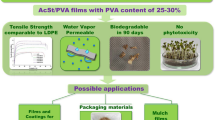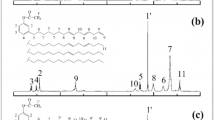Abstract
Purpose. In polymeric coatings, plasticizers are used to improve the film-forming characteristic of the polymers. In this study, a computerized method (VolSurf with GRID) was used as a novel tool for the prediction plasticization efficiency (β) of test compounds, and for determining the critical molecular properties needed for polymer plasticization.
Methods. The film-former, starch acetate DS 2.8 (SA), was plasticized with each of 24 tested compounds. A decrease in glass transition temperature of the plasticized free films (determined by differential scanning calorimeter (DSC)) was used as an indicator for β. Partial least squares discriminant analysis was used to correlate the experimental data with the theoretical molecular properties of the plasticizers.
Results. A good correlation (r2 = 0.77, q2 = 0.58) between the molecular modeling results and the experimental data demonstrated that β can be predicted from the three-dimensional molecular structure of a compound. Favorable structural properties identified for the potent SA plasticizer were strong hydrogen bonding capacity and a definitive hydrophobic region on the molecule.
Conclusions. The VolSurf method is a valuable tool for predicting the plasticization efficiency of a compound. The correlation between experimental and calculated glass transition temperature values verifies that physicochemical properties are primary factors influencing plasticization efficiency of a compound.
Similar content being viewed by others
REFERENCES
J. E. Hogan. Film-coating materials and their properties. In G. Cole (ed.), Pharmaceutical Coating Technology, Taylor & Francis Ltd, London, United Kingdom, 1995 pp. 6-52.
M. A. García, M. N. Martino, and N. E. Zaritzky. Plasticized starch-based coatings to improve strawberry (Fragaria × Ananassa) quality and stability. J. Agric. Food Chem. 46:3758-3767 (1998).
F. Debeaufort and A. Voilley. Methylcellulose-based edible films and coatings: 2. Mechanical and thermal properties as a function of plasticizer content. J. Agric. Food Chem. 45:685-689 (1997).
F. V. Billmeyer. Plastics technology. In F. V. Billmeyer (ed.), Textbook of Polymer Science, 2nd ed., John Wiley & Sons, New York, 1971 pp. 491-512.
G. S. Banker. Film coating theory and practice. J. Pharm. Sci. 55:81-89 (1966).
P. S. Shah and J. L. Zatz. Plasticization of cellulose esters used in the coating of sustained release solid dosage forms. Drug Dev. Ind. Pharm. 18:1759-1772 (1992).
S.-Y. Lin, C.-J. Lee, and Y.-Y. Lin. The effect of plasticizers on compatibility, mechanical properties, and adhesion strength of drug-free Eudragit E films. Pharm. Res. 8:1137-1143 (1991).
A. Schade, T. Niwa, H. Takeuchi, T. Hino, and Y. Kawashima. Aqueous colloidal polymer dispersions of biodegradable DL-lactide/glycolide copolymer as basis for latex films: a new approach for the development of biodegradable depot system. Int. J. Pharm. 117:209-217 (1995).
J. C. Gutiérrez-Rocca and J. W. McGinity. Influence of water soluble and insoluble plasticizers on the physical and mechanical properties of acrylic resin copolymers. Int. J. Pharm. 103:293-301 (1994).
B. C. Hancock, P. York, and R. C. Rowe. The use of solubility parameters in pharmaceutical dosage form design. Int. J. Pharm. 148:1-21 (1997).
F. N. Kelley and F. Bueche. Viscosity and glass temperature relations for polymer-diluent systems. J. Polym. Sci. L:549-556 (1961).
M. C. Righetti, G. Ajroldi, and G. Pezzin. The glass transition temperature of polymer-diluent systems. Polymer 33:4779-4785 (1992).
B. C. Hancock and G. Zografi. The relationship between the glass transition temperature and the water content of amorphous pharmaceutical solids. Pharm. Res. 11:471-477 (1994).
H. A. Schneider. Glass transition behaviour of compatible polymer blends. Polymer 30:771-779 (1989).
L. H. Alifrangis, I. T. Christensen, A. Berglund, M. Sandberg, L. Hovgaard, and S. Frokjaer. Structure-property model for membrane partitioning of oligopeptides. J. Med. Chem. 43:103-113 (2000).
G. Cruciani, M. Pastor, and W. Guba. VolSurf: a new tool for the pharmacokinetic optimization of lead compounds. Eur. J. Pharm. Sci. 11(Suppl.):29-39 (2000).
P. Crivori, G. Cruciani, P.-A. Carrupt, and B. Testa. Predicting blood-brain barrier permeation from three-dimensional molecular structure. J. Med. Chem. 43:2204-2216 (2000).
U. Norinder, T. Österberg, and P. Artursson. Theoretical calculation and prediction of intestinal absorption of drugs in humans using MolSurf parametrization and PLS statistics. Eur. J. Pharm. Sci. 8:49-56 (1999).
E. Filipponi, G. Cruciani, O. Tabarrini, V. Cecchetti, and A. Fravolini. QSAR study and VolSurf characterization of anti-HIV quinolone library. J. Comput. Aided Mol. Design 15:203-217 (2001).
G. Cruciani, P. Crivori, P.-A. Carrupt, and B. Testa. Molecular fields in quantitative structure-permeation relationships: the Vol-Surf approach. J. Mol. Struct. (Theochem) 503:17-30 (2000).
M. Ahola, P. Tiihonen, R. Sutinen, S. Peltonen, and P. Paronen. Novel polymer — starch acetate — for tablet coating. Eur. J. Pharm. Sci. 8(Suppl.):38-39 (1999).
A. H. Young. Fractionation of starch. In R. L. Whistler, J. N. Bemiller, and E. F. Paschall (eds.), Starch: Chemistry and Technology, 2nd ed., Academic Press, San Diego, California, 1984 pp. 249-283.
P. J. Goodford. A computational procedure for determining energetically favorable binding sites on biologically important macromolecules. J. Med. Chem. 28:849-857 (1985).
T. P. Paronen, S. Peltonen, A. Urtti, and L. Nakari. Starch acetate composition with modifiable properties, method for preparation and usage thereof. US Patent 5667803 (1997).
A. O. Okhamafe and P. York. Studies of interaction phenomena in aqueous-based film coatings containing soluble additives using thermal analysis techniques. J. Pharm. Sci. 77:438-443 (1988).
Molecular Discovery Limited. GRID software Linux-version, Molecular Discovery Limited, Oxford, England (2000).
J. C. Gutiérrez-Rocca and J. W. McGinity. Influence of aging on the physical-mechanical properties of acrylic resin films cast from aqueous dispersions and organic solutions. Drug Dev. Ind. Pharm. 19:315-332 (1993).
A. O. Okhamafe and P. York. Thermal characterization of drug/polymer and excipient/polymer interactions in some film coating formulation. J. Pharm. Pharmacol. 41:1-6 (1989).
T. A. Wheatley and C. R. Steuernagel. Latex emulsions for controlled drug delivery. In J. W. McGinity (ed.), Aqueous Polymeric Coatings for Pharmaceutical Dosage Forms, 2nd ed., Marcel Dekker, Inc., New York, 1997 pp. 1-54.
B. Garnaik and S. Sivaram. Study of polymer-plasticizer interaction by 13C CP/MAS NMR spectroscopy: Poly(vinyl chloride)-Bis(2-ethylhexyl) phthalate system. Macromolecules 29:185-190 (1996).
Author information
Authors and Affiliations
Rights and permissions
About this article
Cite this article
Tarvainen, M., Sutinen, R., Somppi, M. et al. Predicting Plasticization Efficiency from Three-Dimensional Molecular Structure of a Polymer Plasticizer. Pharm Res 18, 1760–1766 (2001). https://doi.org/10.1023/A:1013386900232
Issue Date:
DOI: https://doi.org/10.1023/A:1013386900232




